Tensile and Fixed Elongation Properties of Polymer-Based Cement Flexible Composite under Water/Corrosive Solution Environment
Abstract
:1. Introduction
2. Experimental Details
2.1. Materials and Specimen Preparation
2.2. Experimental Method
2.2.1. Durability Test Conditions and Test Scheme
2.2.2. Fixed Elongation and Tensile Test
3. Results and Discussion
3.1. Effect of Water
3.1.1. Elastic Recovery Ratio
3.1.2. Tensile Properties
3.1.3. Discussion
3.2. Effect of Corrosion Environment
3.2.1. Elastic Recovery Ratio
3.2.2. Tensile Properties
3.2.3. Discussion
3.3. Durability Analysis
4. Conclusions
- PCFC exhibited high erosion resistance against water and corrosion solution. Within fixed elongation experimental limits, PCFC specimens had good cohesive performance and retained more than 60% elastic recovery ratio.
- After water immersion, the joint sealant became soft under the ‘plasticizing’ action of water. The tensile strength decreased by at most 45% and the peak strain increased by at most 34%. After the drying–wetting cycle treatment, the tensile properties of the joint sealant decreased significantly except for the tensile strength which initially increased and thereafter decreased with increasing cycles.
- After acid solution and alkali solution immersion, the overall decline of the tensile, deformation, energy consumption indexes and elastic recovery rate of the PCFC was minor and no significant degradation performance occurred. with the extension of the immersion time. At immersion time in the range 1–30 days, the tensile strength does not change by more than 0.07 MPa. After jet fuel immersion, the tensile properties of the joint filler significantly deteriorated.
Author Contributions
Funding
Acknowledgments
Conflicts of Interest
References
- Wang, D.Y.; Fei, W.S. Joint Issue Discussion on Cement Concrete Pavement. Adv. Mater. Res. 2013, 671–674, 1179–1182. [Google Scholar] [CrossRef]
- Monical, J.; Unal, E.; Barrett, T.; Farnam, Y.; Weiss, W.J. Reducing Joint Damage in Concrete Pavements: Quantifying Calcium Oxychloride Formation. Transp. Res. Rec. 2016, 2577, 17–24. [Google Scholar] [CrossRef]
- Shill, S.K.; Al-Deen, S.; Ashraf, M.; Hutchison, W.; Hossain, M.M. Performance of Amine Cured Epoxy and Silica Fume Modified Cement Mortar Under Military Airbase Operating Conditions. Constr. Build. Mater. 2020, 232, 117280. [Google Scholar] [CrossRef]
- Suraneni, P.; Jafari Azad, V.; Isgor, O.; Weiss, W. Deicing Salts and Durability of Concrete Pavements and Joints: Mitigating Calcium Oxychloride Formation. Concr. Int. 2016, 38, 48–54. [Google Scholar]
- Li, W.; Pour-Ghaz, M.; Castro, J.; Weiss, J. Water Absorption and Critical Degree of Saturation Relating to Freeze-Thaw Damage in Concrete Pavement Joints. J. Mater. Civ. Eng. 2012, 24, 299–307. [Google Scholar] [CrossRef]
- Shill, S.K.; Al-Deen, S.; Ashraf, M. Concrete Durability Issues Due to Temperature Effects and Aviation Oil Spillage at Military Airbase—A Comprehensive Review. Constr. Build. Mater. 2018, 160, 240–251. [Google Scholar] [CrossRef]
- Weiss, W.J. Concrete Pavement Joint Durability: A Sorption-Based Model for Saturation, the Role of Distributed Cracking, and Calcium Oxychloride Formation. In Proceedings of the CONCREEP 10, Vienna, Austria, 21–23 September 2015; pp. 211–218. [Google Scholar]
- Wang, X.; Li, W.; Yuan, J. Performance Analysis of the Joint Sealing Materials for the Cement Concrete Pavements in Civil Airports. J. Highw. Transp. Res. Dev. (Engl. Ed.) 2017, 11, 1–8. [Google Scholar] [CrossRef]
- Li, Q.; Crowley, R.W.; Bloomquist, D.B.; Roque, R. Newly Developed Adhesive Strength Test for Measuring the Strength of Sealant between Joints of Concrete Pavement. J. Mater. Civ. Eng. 2014, 26, 04014097. [Google Scholar] [CrossRef]
- Channakeshava, C.; Barzegar, F.; Voyiadjis, G.Z. Nonlinear FE Analysis of Plain Concrete Pavements with Doweled Joints. J. Transp. Eng. 1993, 119, 763–781. [Google Scholar] [CrossRef]
- Mehta, Y.; Cleary, D.; Ali, A.W. Field Cracking Performance of Airfield Rigid Pavements. J. Traffic Transp. Eng. (Engl. Ed.) 2017, 4, 380–387. [Google Scholar] [CrossRef]
- Shen, D.; Shi, S.; Xu, T.; Huang, X.; Liao, G.; Chen, J. Development of Shape Memory Polyurethane Based Sealant for Concrete Pavement. Constr. Build. Mater. 2018, 174, 474–483. [Google Scholar] [CrossRef]
- Biel, T.D.; Lee, H. Performance Study of Portland Cement Concrete Pavement Joint Sealants. J. Transp. Eng. 1997, 123, 398–404. [Google Scholar] [CrossRef]
- Shen, D.; Shi, S.; Xu, T. Synthesis and Performance Evaluation of Epoxy Resin–Modified Shape Memory Polyurethane Sealant. J. Test. Eval. 2018, 46, 1452–1461. [Google Scholar] [CrossRef]
- Li, G.; King, A.; Xu, T.; Huang, X. Behavior of Thermoset Shape Memory Polymer-Based Syntactic Foam Sealant Trained by Hybrid Two-Stage Programming. J. Mater. Civ. Eng. 2013, 25, 393–402. [Google Scholar] [CrossRef]
- Li, G.; Ji, G.; Meng, H. Shape Memory Polymer-Based Sealant for a Compression Sealed Joint. J. Mater. Civ. Eng. 2015, 27, 04014196. [Google Scholar] [CrossRef]
- Li, G.; Xu, T. A Shape Memory Polymer Based Self-Healing Syntactic Foam Sealant for Expansion Joint. In Proceedings of the Structures Congress 2011, Las Vegas, NV, USA, 14–16 April 2011; pp. 2078–2089. [Google Scholar]
- Zotti, A.; Zuppolini, S.; Borriello, A.; Zarrelli, M. Thermal Properties and Fracture Toughness of Epoxy Nanocomposites Loaded with Hyperbranched-Polymers-Based Core/Shell Nanoparticles. Nanomaterials 2019, 9, 418. [Google Scholar] [CrossRef] [Green Version]
- Kwiecień, A.; Gruszczyński, M.; Zajac, B. Tests of Flexible Polymer Joints Repairing of Concrete Pavements and of Polymer Modified Concretes Influenced by High Deformations. Key Eng. Mater. 2011, 466, 225–239. [Google Scholar] [CrossRef] [Green Version]
- Sikora, P.; Łukowski, P.; Cendrowski, K.; Horszczaruk, E.; Mijowska, E. The Effect of Nanosilica on the Mechanical Properties of polymer-Cement Composites (PCC). Procedia Eng. 2015, 108, 139–145. [Google Scholar] [CrossRef] [Green Version]
- Xu, D.; Xin, C.; Huang, S. Investigation of Inorganic Fillers on Properties of 2-2 Connectivity Cement/Polymer Based Piezoelectric Composites. Constr. Build. Mater. 2015, 94, 678–683. [Google Scholar]
- Hussain, H.K.; Liu, G.W.; Yong, Y.W. Experimental Study to Investigate Mechanical Properties of New Material Polyurethane–Cement Composite (PUC). Constr. Build. Mater. 2014, 50, 200–208. [Google Scholar] [CrossRef]
- Caimi, S.; Timmerer, E.; Banfi, M.; Storti, G.; Morbidelli, M. Core-Shell Morphology of Redispersible Powders in Polymer-Cement Waterproof Mortars. Polymers 2018, 10, 1122. [Google Scholar] [CrossRef] [Green Version]
- Barnat-Hunek, D.; Łagód, G.; Fic, S.; Jarosz-Hadam, M. Effect of Polysiloxanes on Roughness and Durability of Basalt Fibres–Reinforced Cement Mortar. Polymers 2018, 10, 420. [Google Scholar] [CrossRef] [Green Version]
- Sherir, M.; Hossain, K.; Lachemi, M. Structural Performance of Polymer Fiber Reinforced Engineered Cementitious Composites Subjected to Static and Fatigue Flexural Loading. Polymers 2015, 7, 1299–1330. [Google Scholar] [CrossRef] [Green Version]
- Bian, X.; Zeng, L.; Deng, Y.; Li, X. The Role of Superabsorbent Polymer on Strength and Microstructure Development in Cemented Dredged Clay with High Water Content. Polymers 2018, 10, 1069. [Google Scholar] [CrossRef] [Green Version]
- Won, J.; Kang, H.; Lee, S.; Kang, J. Eco-Friendly Fireproof High-Strength Polymer Cementitious Composites. Constr. Build. Mater. 2012, 30, 406–412. [Google Scholar] [CrossRef]
- Kim, K.K.; Yeon, J.; Lee, H.J.; Yeon, K. Feasibility Study of SBR-Modified Cementitious Mixtures for Use as 3D Additive Construction Materials. Polymers 2019, 11, 1321. [Google Scholar] [CrossRef] [PubMed] [Green Version]
- Bai, E.; Liu, G.; Xu, J.; Yang, N.; Wen, C. Tensile Properties of a Flexible Polymer-Cement Composite Containing Portland Cement and Vae Emulsion. Ceramics–Silikáty 2020, 64, 92–99. [Google Scholar] [CrossRef] [Green Version]
- Test Method for Building Sealants; GB/T 13477-2002; General Administration of Quality Supervision, Inspection and Quarantine of the People’s Republic of China: Beijing, China, 2002.
- Rashid, K.; Ueda, T.; Zhang, D.; Miyaguchi, K.; Nakai, H. Experimental and Analytical Investigations on the Behavior of Interface between Concrete and Polymer Cement Mortar under Hygrothermal Conditions. Constr. Build. Mater. 2015, 94, 414–425. [Google Scholar] [CrossRef]
- Diamanti, M.V.; Brenna, A.; Bolzoni, F.; Berra, M.; Pastore, T.; Ormellese, M. Effect of Polymer Modified Cementitious Coatings on Water and Chloride Permeability in Concrete. Constr. Build. Mater. 2013, 49, 720–728. [Google Scholar] [CrossRef]
- Gómez Hoyos, C.; Vázquez, A. Flexural Properties Loss of Unidirectional Epoxy/Fique Composites Immersed in Water and Alkaline Medium for Construction Application. Compos. Part B Eng. 2012, 43, 3120–3130. [Google Scholar] [CrossRef]
- Wang, H.; Xian, G.; Li, H.; Sui, L. Durability Study of a Ramie-Fiber Reinforced Phenolic Composite Subjected to Water Immersion. Fibers Polym. 2014, 15, 1029–1034. [Google Scholar] [CrossRef]
- Snoeck, D.; De Belie, N. Repeated Autogenous Healing in Strain-Hardening Cementitious Composites by Using Superabsorbent Polymers. J. Mater. Civ. Eng. 2016, 28, 04015086. [Google Scholar] [CrossRef] [Green Version]
- Biscaia, H.C.; Silva, M.A.G.; Chastre, C. An Experimental Study of GFRP-to-concrete Interfaces Submitted to Humidity Cycles. Compos. Struct. 2014, 110, 354–368. [Google Scholar] [CrossRef]
- Lu, Z.; Kong, X.; Yang, R.; Zhang, Y.; Jiang, L.; Wang, Z.; Wang, Q.; Liu, W.; Zeng, M.; Zhou, S.; et al. Oil Swellable Polymer Modified Cement Paste: Expansion and Crack Healing upon Oil Absorption. Constr. Build. Mater. 2016, 114, 98–108. [Google Scholar] [CrossRef]
- Irfan, M.; Saeed, M.; Ahmed, S.; Ali, Y. Performance Evaluation of Elvaloy as a Fuel-Resistant Polymer in Asphaltic Concrete Airfield Pavements. J. Mater. Civ. Eng. 2017, 29, 04017163. [Google Scholar] [CrossRef]
- Sokołowska, J.J.; Woyciechowski, P.; Adamczewski, G. Influence of Acidic Environments on Cement and Polymer-Cement Concretes Degradation. Adv. Mater. Res. 2013, 687, 144–149. [Google Scholar] [CrossRef]
- Omrane, M.; Mouli, M.; Benosman, A.S.; Senhadji, Y. Deterioration of Mortar Composites in Acidic Environment. Adv. Mater. Res. 2015, 1064, 3–8. [Google Scholar] [CrossRef]
- Muhammad, B.; Ismail, M. Performance of Natural Rubber Latex Modified Concrete in Acidic and Sulfated Environments. Constr. Build. Mater. 2012, 31, 129–134. [Google Scholar] [CrossRef]
- Wang, S.; Ma, G.; Wu, Y.; Liu, X.; Huang, C.; Liu, X.; Sang, Y.; Kong, D. Technical Indexes Studies on Sealing Materials for Airport Concrete Pavement. Ind. Constr. 2003, 33, 52–55. (In Chinese) [Google Scholar]



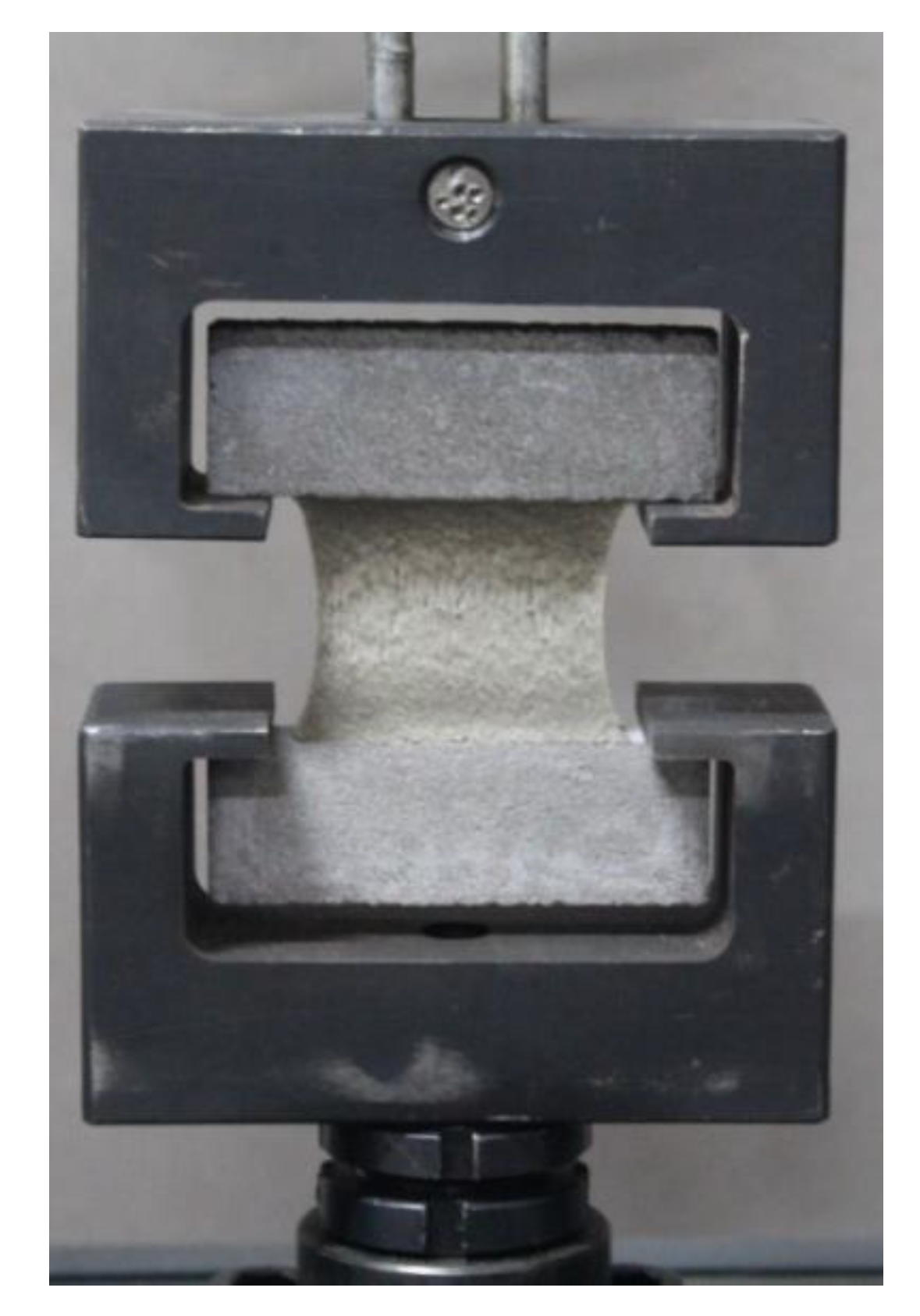
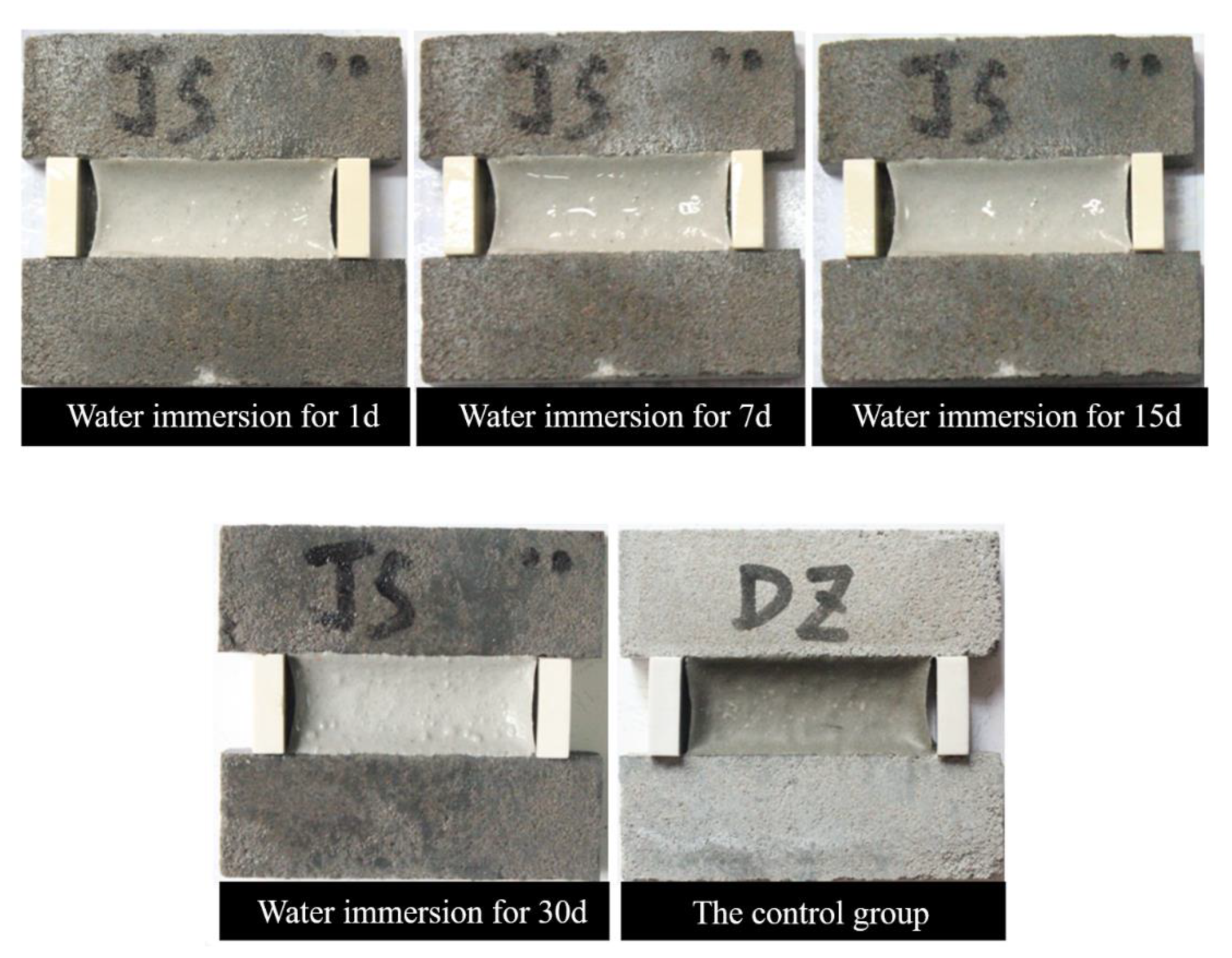


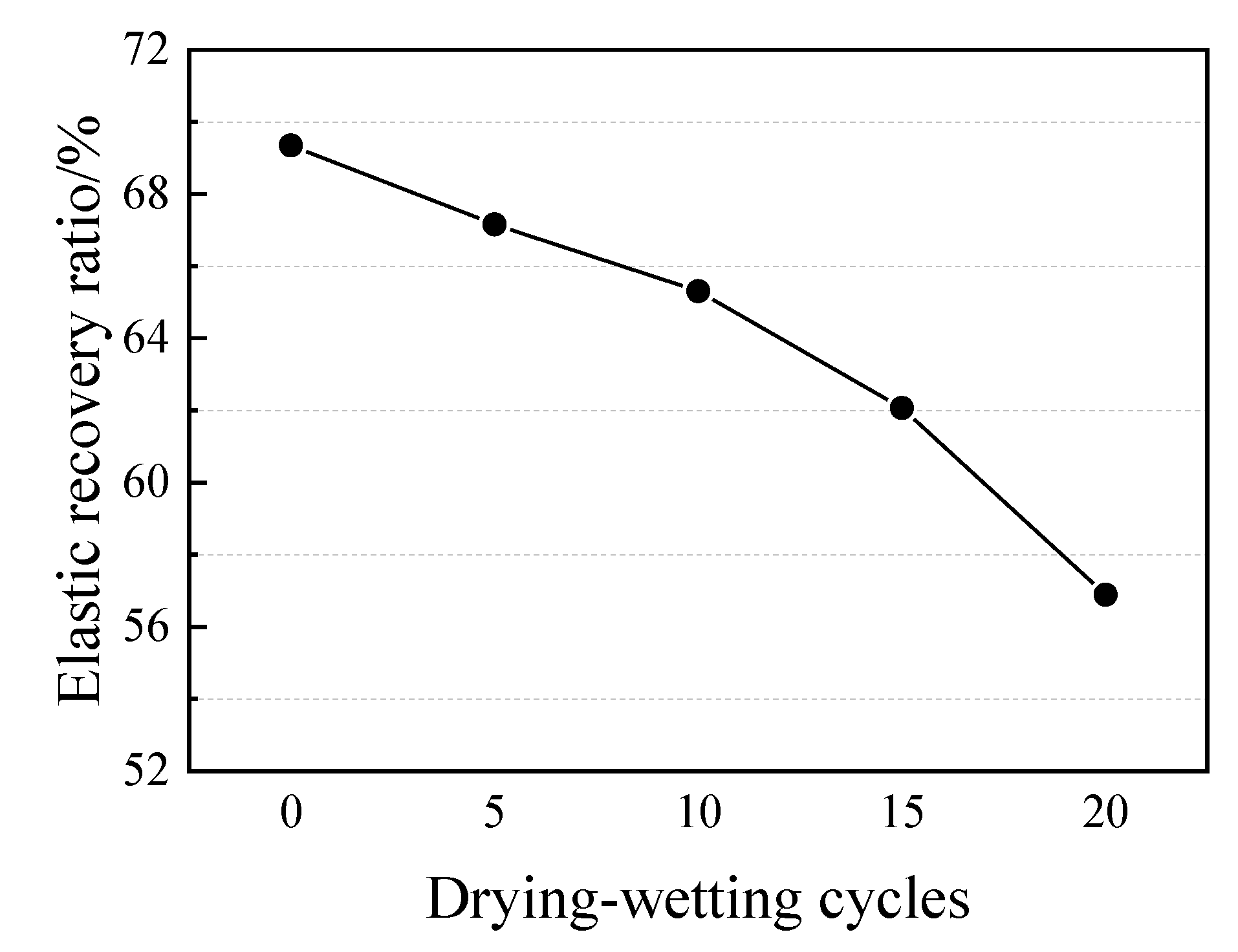
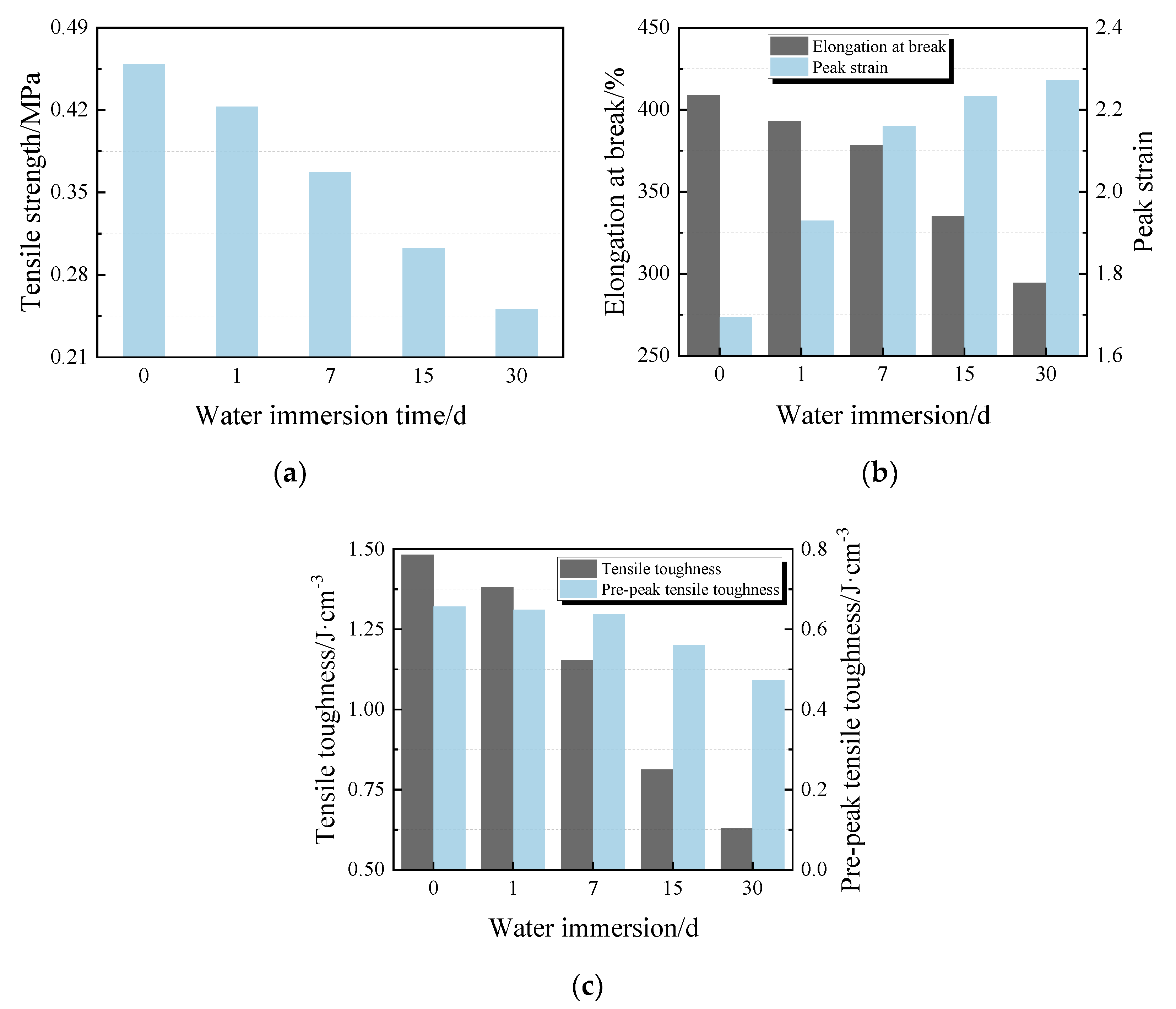
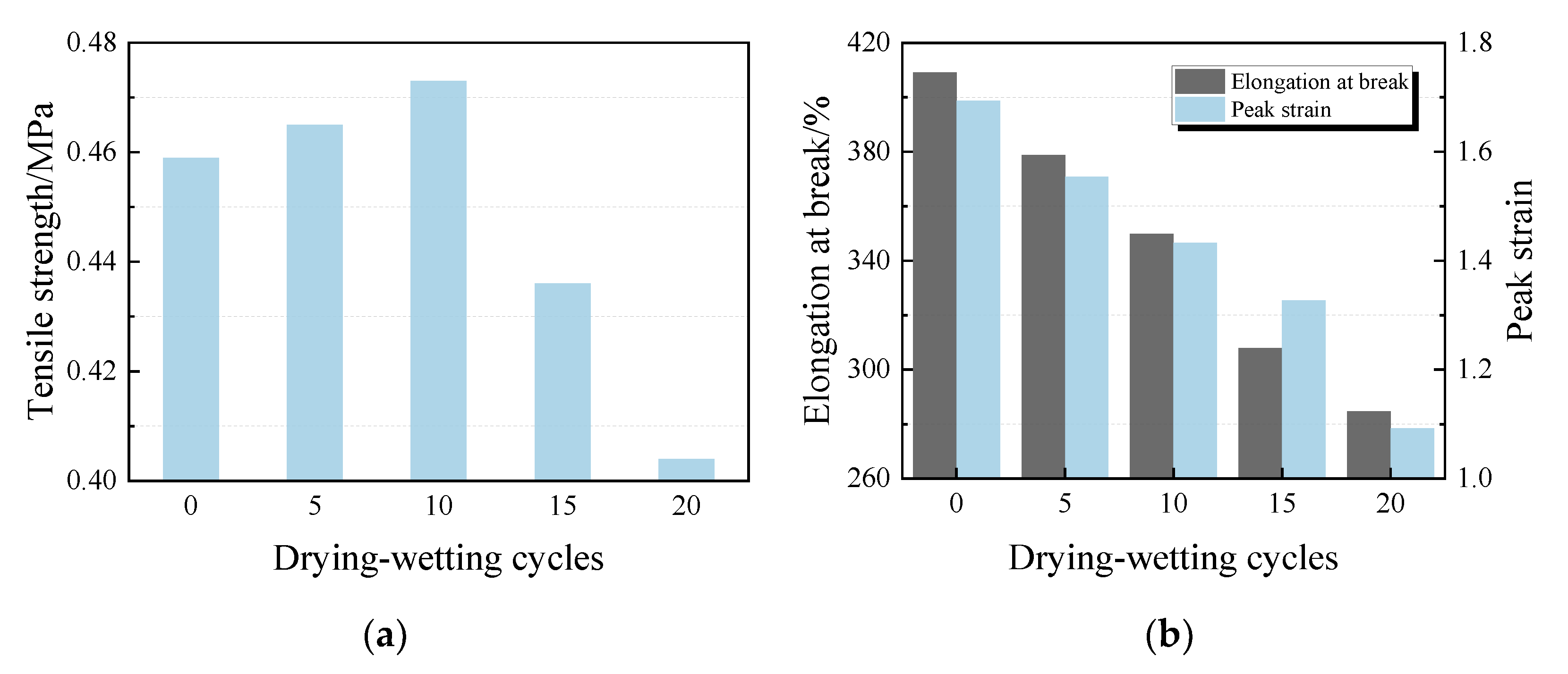
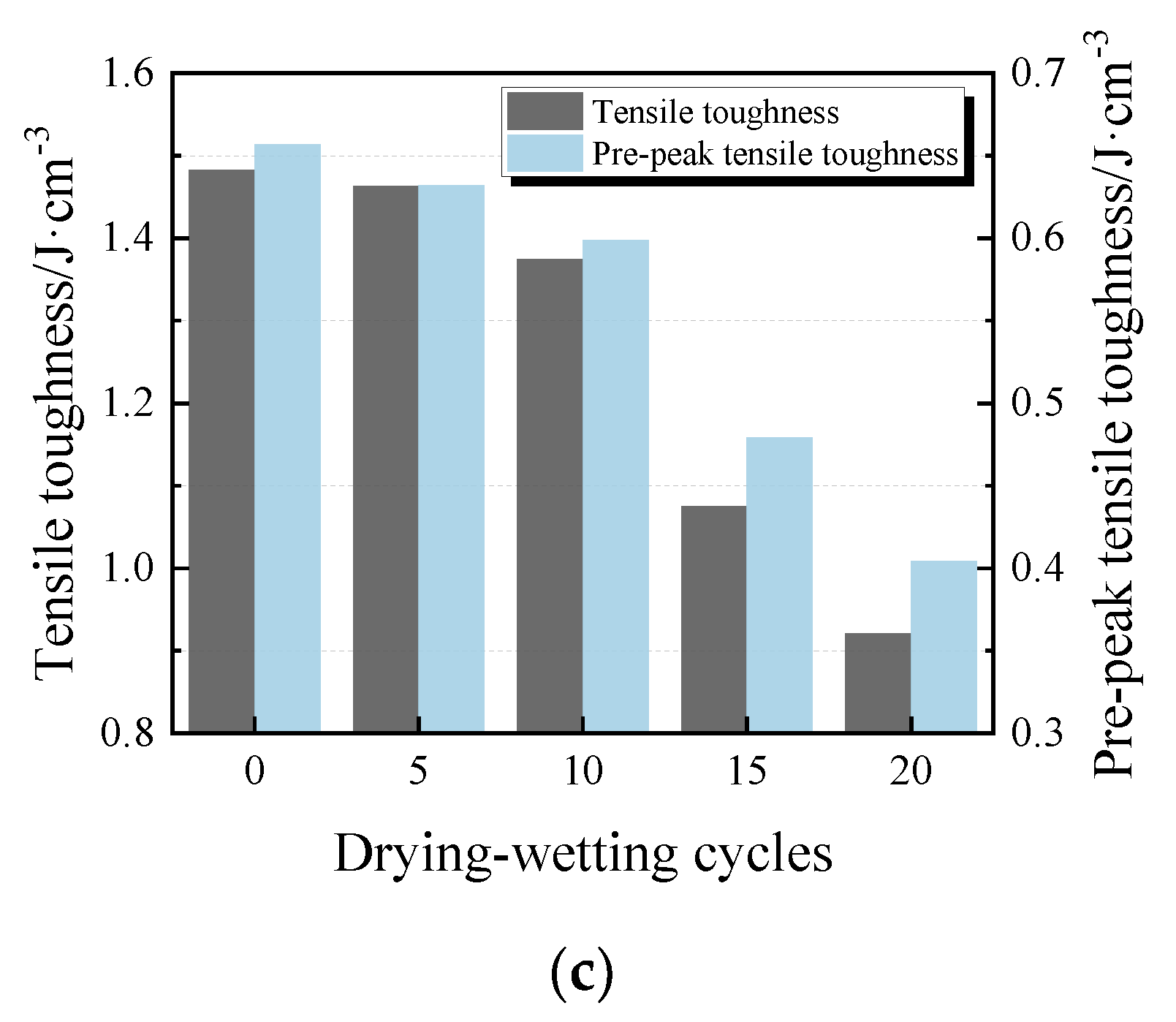
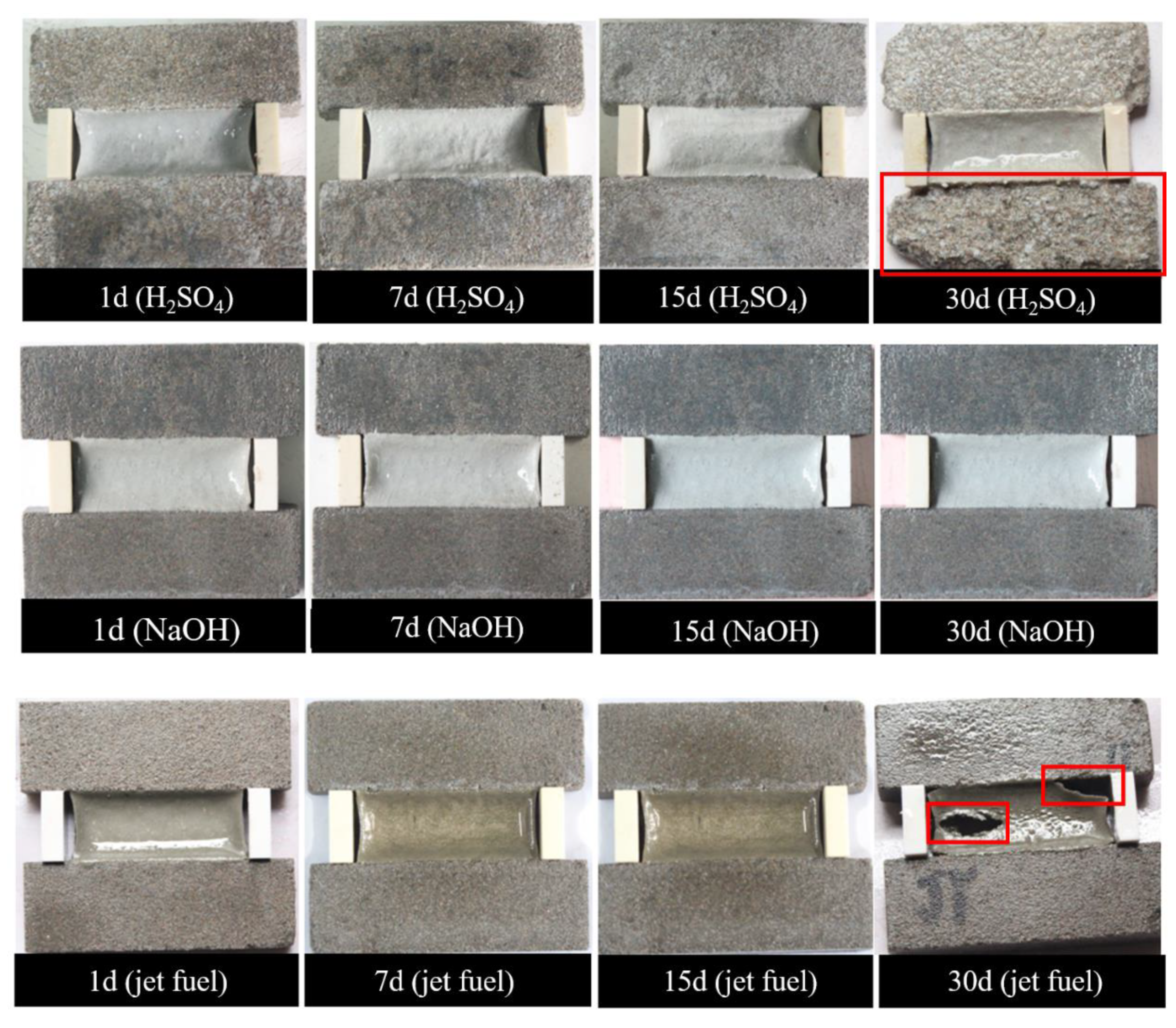

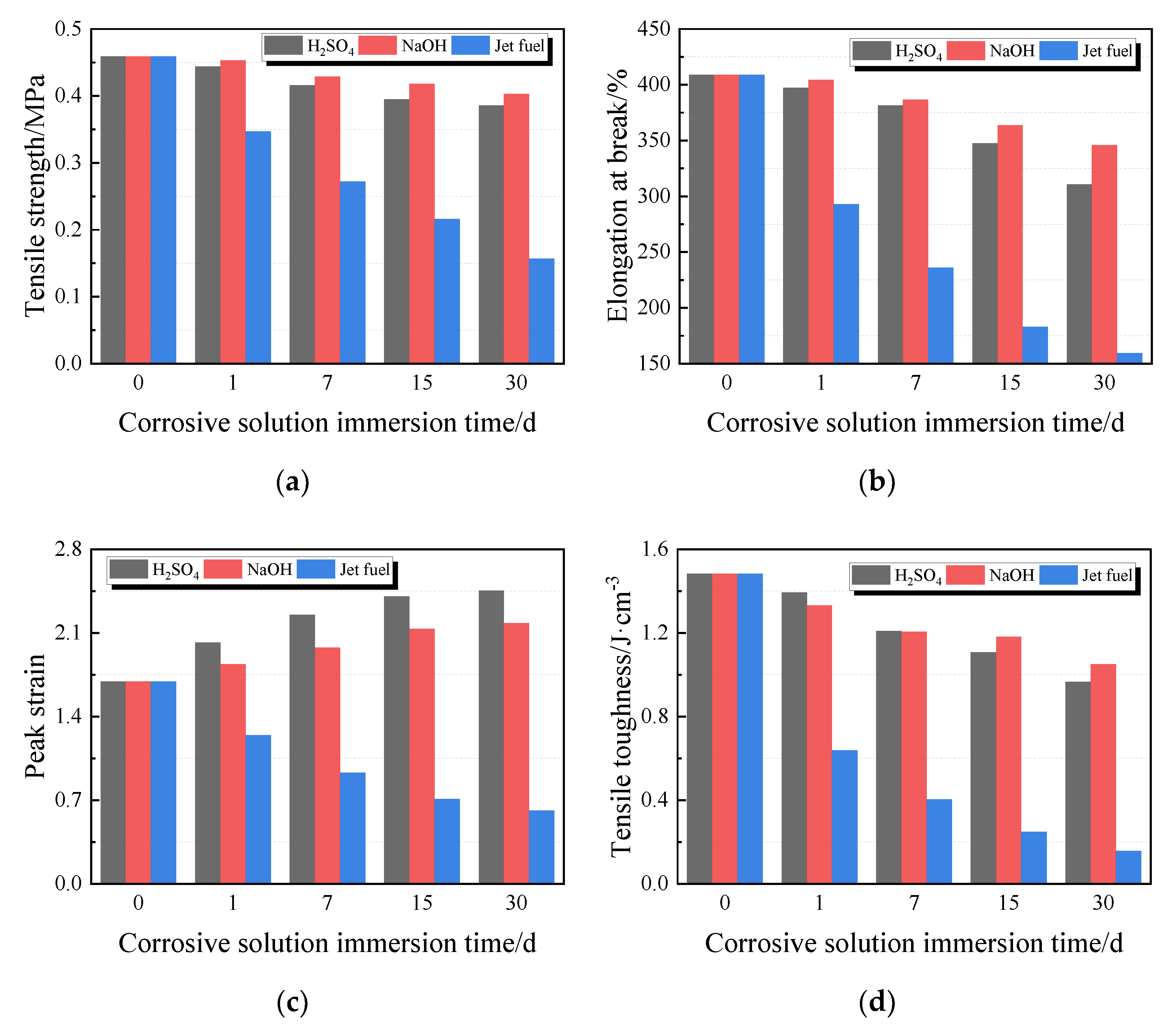
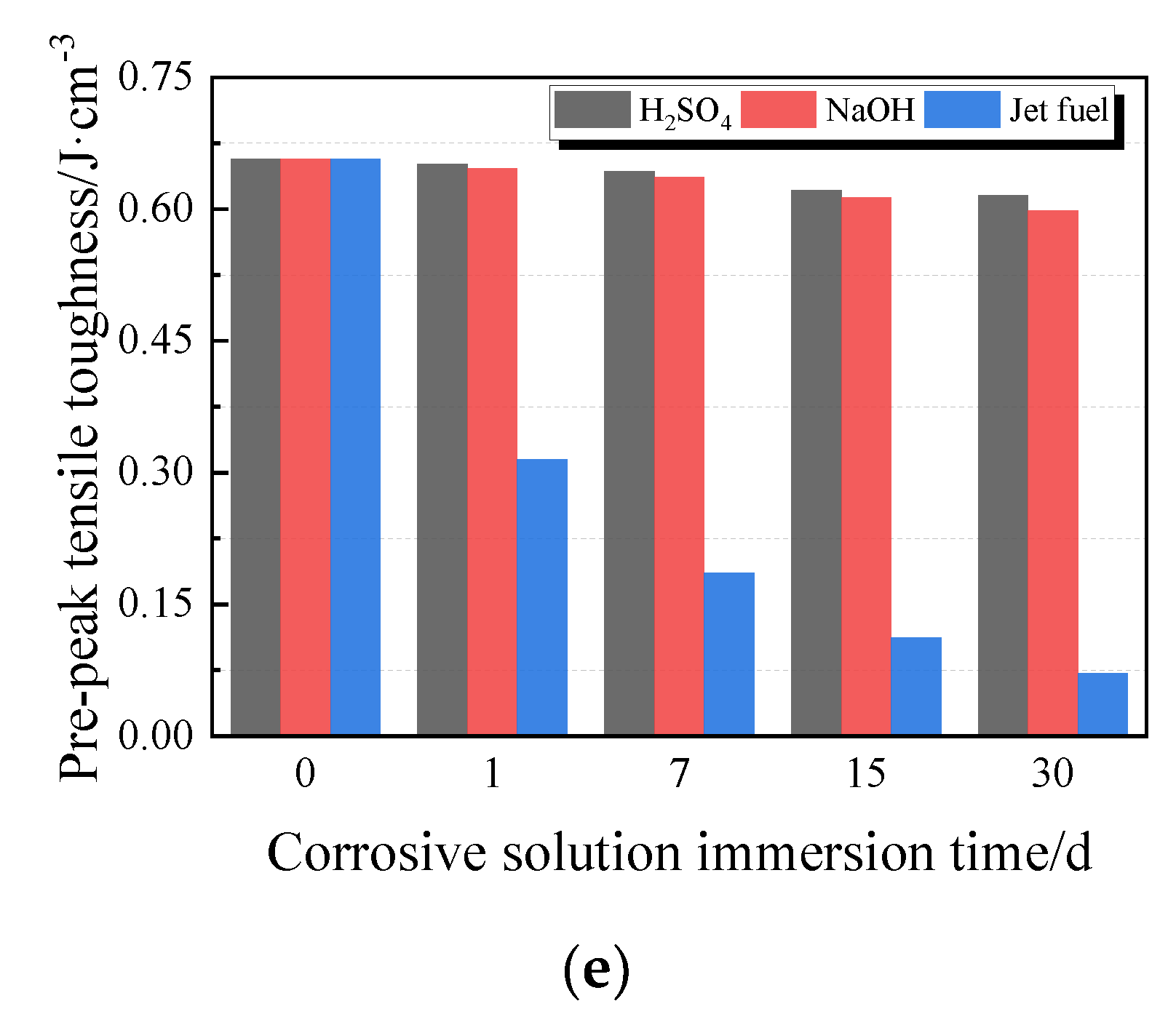

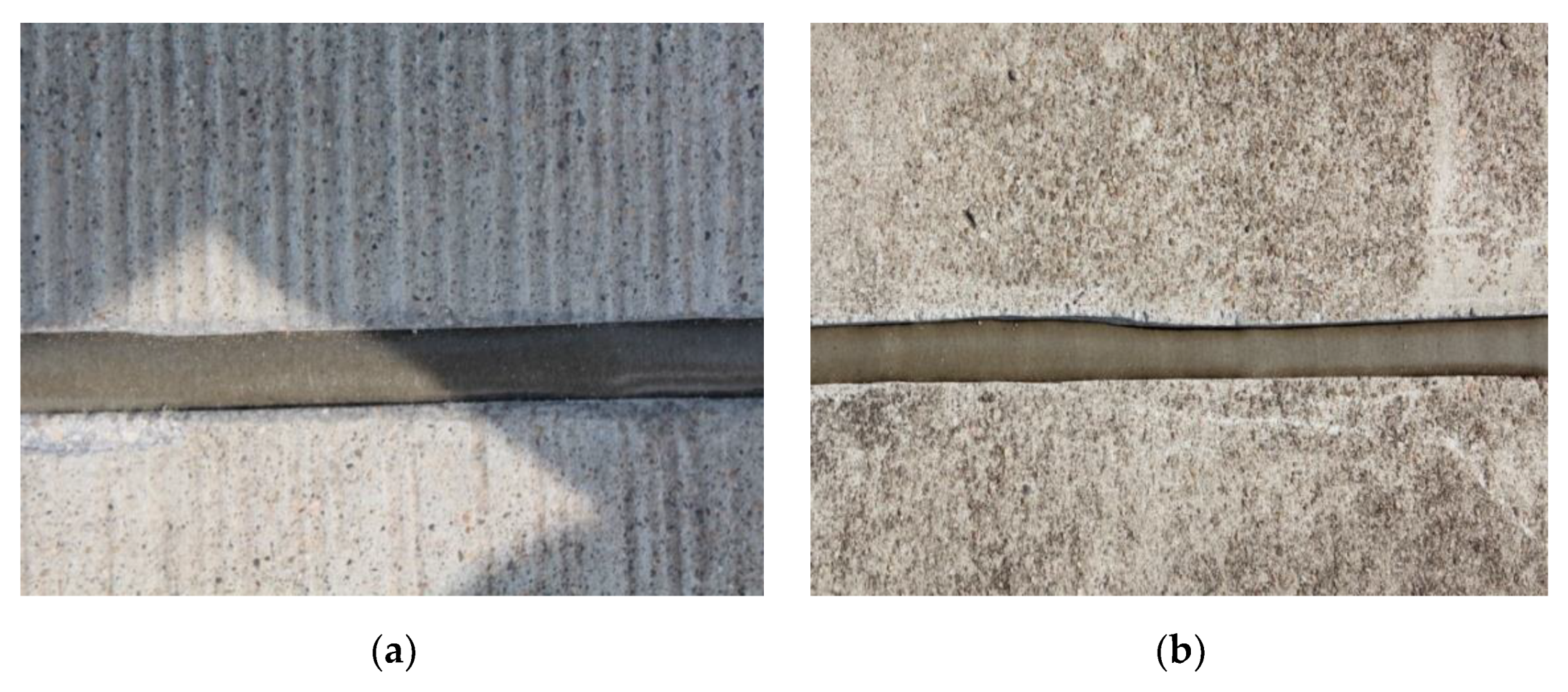
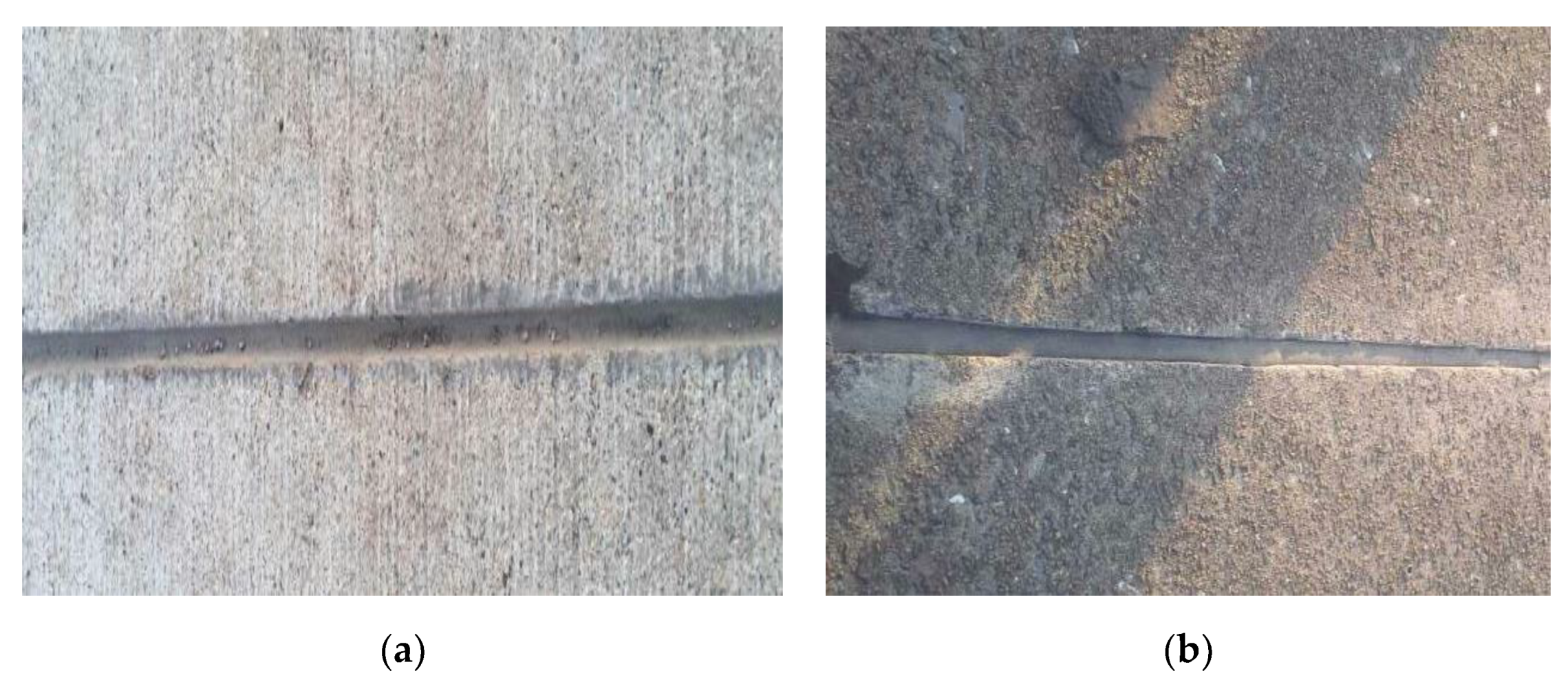
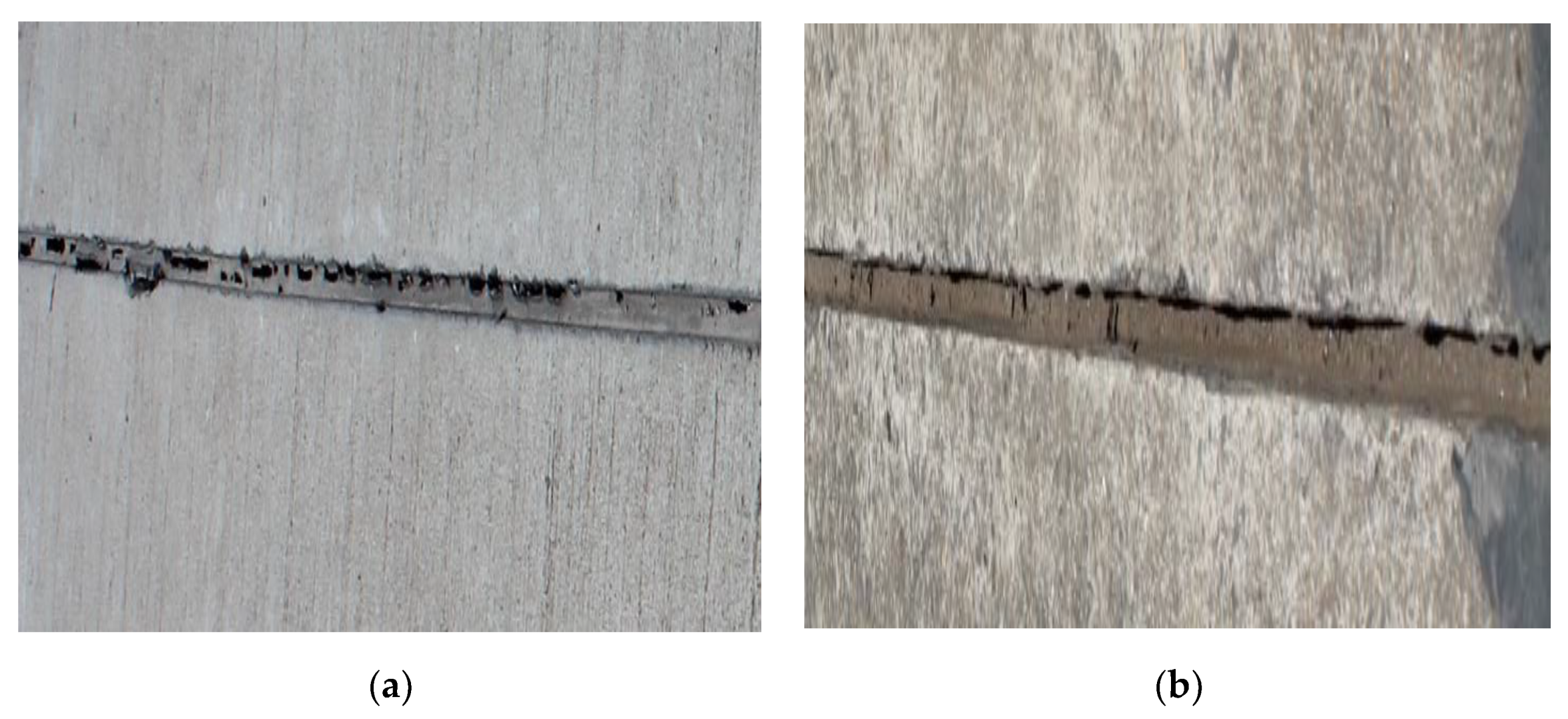
| Emulsion | Chemical Compositions | Solid Content (%) | Viscosity (mPa·s) | pH | Tg (°C) | Minimum Film Forming Temperature (°C) | Average Granularity (μm) |
|---|---|---|---|---|---|---|---|
| Styrene–acrylic | Styrene–acrylate copolymer | 56 ± 1 | 400–1800 | 7.0–8.5 | −7 | 0 | 0.1 |
| VAE | Ethylene–vinyl acetate copolymer | 55 ± 1 | 1500–5000 | 4.5–6.0 | −10 | 0 | 1.5 |
| Materials | Quantity (kg/m3) | Percentage (%) |
|---|---|---|
| Styrene–acrylic emulsion | 1086.8 | 43.47 |
| VAE emulsion | 585.2 | 23.41 |
| Cement | 234.1 | 9.36 |
| Talcum powder | 217.4 | 8.70 |
| Heavy calcium carbonate | 217.4 | 8.70 |
| Dispersant | 18.7 | 0.75 |
| Defoamer | 11.7 | 0.47 |
| Film-forming additive | 100.3 | 4.01 |
| Silane coupling agents | 11.7 | 0.47 |
| Plasticizers | 16.7 | 0.67 |
| Environmental Effects | Conditions | Processes |
|---|---|---|
| Effect of water | Water immersion | The specimens were immersed into water (maintained at 25 °C) for 1, 7, 15, and 30 days, respectively. Afterwards, the surface moisture was removed and their mechanical properties immediately tested. |
| Drying–wetting cycle | The specimens were immersed into water (maintained at 25 °C) for 2 days, and then dried in oven (25 °C) for 1 day (one cycle). The specimens were subjected to 5, 10, 15, 20 cycles and the mechanical properties immediately tested. | |
| Effect of corrosive solution | Acid solution immersion | The specimens were immersed into corrosive solution (H2SO4, NaOH and jet fuel) for 1, 7, 15, and 30 days. Afterwards, the surface solution was removed and the mechanical property immediately tested. |
| Alkaline solution immersion | ||
| Jet fuel immersion |
| Performance | Part of the Durability Requirements Proposed by Wang [42] | Result |
|---|---|---|
| Resistance to water | Elongation with 60% of its original width after water immersion (23 °C × 24 h), no failure | No failure, 61.13% elastic recovery (23 °C × 30 days) |
| Resistance to the jet fuel | Elongation with 60% of its original width after jet fuel immersion (23 °C × 24 h), no failure | No failure, 53.25% elastic recovery (23 °C × 15 days) |
| Resistance to acid | N/A | No failure, 62.93% elastic recovery (23 °C × 30 days) |
| Resistance to alkali | N/A | No failure, 61.97% elastic recovery (23 °C × 30 days) |
© 2020 by the authors. Licensee MDPI, Basel, Switzerland. This article is an open access article distributed under the terms and conditions of the Creative Commons Attribution (CC BY) license (http://creativecommons.org/licenses/by/4.0/).
Share and Cite
Bai, E.-L.; Liu, G.-J.; Xu, J.-Y.; Leng, B.-L. Tensile and Fixed Elongation Properties of Polymer-Based Cement Flexible Composite under Water/Corrosive Solution Environment. Materials 2020, 13, 2155. https://doi.org/10.3390/ma13092155
Bai E-L, Liu G-J, Xu J-Y, Leng B-L. Tensile and Fixed Elongation Properties of Polymer-Based Cement Flexible Composite under Water/Corrosive Solution Environment. Materials. 2020; 13(9):2155. https://doi.org/10.3390/ma13092155
Chicago/Turabian StyleBai, Er-Lei, Gao-Jie Liu, Jin-Yu Xu, and Bing-Lin Leng. 2020. "Tensile and Fixed Elongation Properties of Polymer-Based Cement Flexible Composite under Water/Corrosive Solution Environment" Materials 13, no. 9: 2155. https://doi.org/10.3390/ma13092155
APA StyleBai, E.-L., Liu, G.-J., Xu, J.-Y., & Leng, B.-L. (2020). Tensile and Fixed Elongation Properties of Polymer-Based Cement Flexible Composite under Water/Corrosive Solution Environment. Materials, 13(9), 2155. https://doi.org/10.3390/ma13092155




